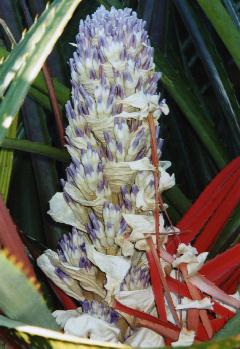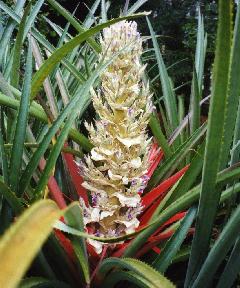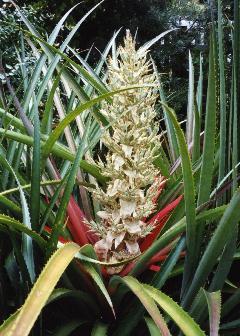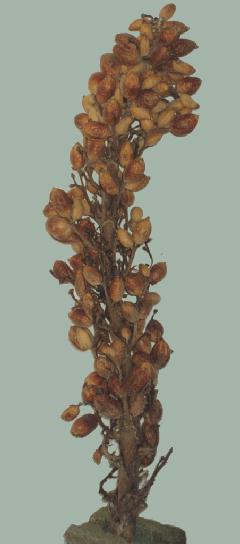








Desc from S&D
Plant flowering to 3 m high, propagating by stout rhizomes to 1 m long;
leaves to 100 or more in a dense rosette, not narrowed between sheath and blade, to 3 m long; outer sheaths short, broadly subtriangular, covered toward apex with linear brown scales, inner sheaths large, elliptic, pale, pale-flocculose; outer blades linear, attenuate, pungent, 20-35 mm wide, laxly serrate with stout antrorse and retrorse curved spines to 8 mm long, glabrous above, minutely pale-lepidote between the nerves beneath, green, the inner blades red and smaller.
Scape usually short but always evident, stout, densely white- flocculose;
scape-bracts like the inner leaves, very densely imbricate.
Inflorescence subcylindric, dense or sublax, 2-10 dm long, 6-30 cm in diameter, minutely white-flocculose except for the petals;
primary bracts like the scape-bracts the uppermost bladeless, the lowest much exceeding the branches;
branches erect or suberect, from a few fasciculate flowers to 12 racemose ones.
Floral bracts broadly subelliptic, obtuse or acute, 6-10 mm long, shorter than the ovary, entire, whitish, submembrana-ceous;
pedicels rather slender, those of the lower flowers to 1 cm long; flowers 35-40 mm long.
Sepals free, erect, elliptic or oblong, obtuse or broadly subacute, slightly if at all carinate, nearly flat, 6-13 mm long, submembranaceous, entire;
petals erect, oblong, obtuse, 25-30 mm long, short-connate with the filaments, purple, glabrous;
stamens included;
ovary cylindric.
Fruit ovoid or ellipsoid, to 50 mm long, 25 mm in diameter.
Type. Typified by original description and later plate.
DISTRIBUTION . Restinga (coastal scrub) or forest, from near sea level to 1000 m alt, southeastern Brazil and Uruguay.
BRAZIL. Sellow 3344 (GH, R, US). Rio de Janeiro: Jurujuba, Dec 1890, Schwacke s n (R); Itatiaia, 1 Jan 1929, L. B. Smith 1610 (GH); Sao Joao da Barra, 10 Sep 1953, Segadas-Vianna et al no. Restinga-l-282 (R, US). (GUANABARA): Vila Isabel to Engenho Novo, 4 Nov 1879, Glaziou 12234 (P). Lagoa Rodrigo de Freitas, Oct 1895, Ule 4613 in part (R); Copacabana, Nov 1897, Ule 4613 in part (HBG); Praia Leblon, Dec 1914, Hoehne 23 (GH, SP); Rio de Janeiro, 19 May 1939, Foster 497 (GH); Corcovado, 5 Nov 1946, Duarte & Paulo 421 (RB); Marambaia, 7 Dec 1966, E. Pereira 10500 (HB). Sao Paulo: Serra de Caracol, 1 Dec 1875, Mosen 4418 (S); Sao Roque, Everett s n (GH); Ipiranga, Oct 1916, Luederwaldt s n (SP); Lorena, Delforge s n (RB); Guaruja, 28 Feb 1929, L. B. Smith 2031 (GH); Jaragua, 15 Nov 1929, M. Hoehne s n (GH, SP); Indaiatuba, Campinas, 21 Nov 1938, Viegas s n (SP); Sao Jose dos Campos, Jan 1962, Mimura 206 (SP, US); 207 (SP, US); Bertioga, 5 Feb 1968, L. 8. Smith & McWilliams 15374 (MICH, R, US). Parand: Jaguariaiva, 13 Oct 1911, Dusen 13286 (S, US); Rio Cavernoso, Guarapuava, 15 Dec 1965, Reitz & Klein 17752 (HBR, US); Pontal do Sul, Paranagua, 30 Dec 1972, Hatschbach 31076 (MBM, US). Santa Catarina: Gaudi¬chaud 129 in part (P); Sanga do Engenho, Criciuma, Reitz C-209 (GH, HBR); Sombrio, 30 Aug 1945, Reitz C-1188 (GH, HBR); 27 Nov 1950, 3897 (HBR); Canto Grande, Porto Belo, 15 Jul 1950, Reitz s n (HBR); Itajuba, Araquari, 11 Jan 1951, Reitz 3758-h (HBR); Rio Vermelho, Florianopolis, 21 Dec 1951, Reitz s n (HBR, US); Papanduva, 13 Dec 1962, Klein 3961 (HBR, US); Campo Ere, 7 Dec 1964, L. B. Smith & Klein 13806 (HBR, R, US). Rio Grande do Sul: Porto Alegre, (892, Lindman A-645 (S); Dec 1898, Reineck s n (GH); Sao Leopoldo, Dec 1943, Eugenio s n (GH); 1941, 129 (R, RB); s d, 132 (NY); 20 Nov 1950, Rambo s n (US). URUGUAY. Rivera: Franqueras, Nov 1890, Arechavaleta s n (MVM). Rocha: Sierras de Rocha, Feb 1925, Jurado s n (BA); Castillos, 21 Jan 1944, Bartlett 21400 (GH, US); Cerro Verde, Coronilla, 18 Jan 1947, Castellanos s n (LIL); Santa Teresa, 1 Dec 1954, Legrand 4429 (MVM). Maldonado: Maldonado, Feb 1946, Castellanos s n (LIL).
Local name. Banana do mato (Brazil, Santa Catarina).
Translated by Derek Butcher
Detail from Reitz in Bromeliaceas e a Malaria 1983 p302- 306
KEY TO THE SPECIES
1 - Branches of the inflorescence distinct; flowers racemose; sepals ecarinate, wide, no more than 3 times longer than wide. = B. antiacantha
1 - Branches of the inflorescence abortive; flowers fasciculate; sepals carinate, narrow, 4 or more times longer than wide. = B. balansae
1. BROMELIA ANTIACANTHA BERTOLONI
[from the word anti (against) and acantha (prickle); refers to the disposition of the spines that in the inferior part of the leaf blade are pointing down and, opposite in the superior part.]
BANANA-DO-MATO
Bertolini. Virid. Bonon. 4.1824; Misc. 4: 6, tab. 1. 1844; Reitz, Anais Bot. Herb. Barbosa Rodrlgues 2: 11. 1950, idem 3: 103. 1951, idem 4: 33. 1952, Sello¬wia 7: 129. 1958, idem 13: 80. 1961, idem 17: 46. 1965, idem 19: 102. 1987, Anais XV Congr. Bot. 239. 1967: L. B. Smith & R. J. Downs Fl. Neotropica 14 (3): 1656. 1979.
Bromelia acanga sensu Willdenow, Enum. 346. 1809; non Linnaeus, 1767.
Bromelia commeliniana de Vriese, Del. Sem. Hort. Amst. 1844 ex Hoeven & de Vriese, Tijdschr. 12: 49. 1845; de Vriese, Descr. & Fig. Pl. Nouv. & Rar. 1: (tab. 1). 1847.
Bromelia sceptrum Fenzl ex Huegel, Parad. Vindob. fasc. 8: tab. 8. 1844-60 (! Mez).
Agallostachys antiacantha (Bertoloni) Beer, Bromel. 37. 1858.
Agallostachys commelliana (De Vriese) Beer, Bromel. 39. 1856.
Bromelia fastuosa sensu Regel, Gartenflora 15: 1, tab. 493. 1868; non Llndley, 1821.
Bromelia pinguin sensu Carriere, Rev. Hortic. 53: 153, figs. 35-39. 1881.
? Hechtia longifolia hortus ex Baker, Handb. Bromel. 130. 1889.
TERRICOLOUS 2m high, stem short, thick, emitting thick stolons, at times, l m.long, decumbent-ascendending, at the top leaflike and the rest scaled.
LEAVES to 100 or more, in general 2m long, in the forests to exceeding 3m, disposed in a rosette without forming a cistern;
SHEATH wide, but blunt, triangular-ovate, not amplexicaule, internally covered with large pale, dense, brown tomentum;
BLADES erect stiff, a little recurved at the top, canaliculate, densely covered with spines at the margins, that are pointing down at the base, then at a certain height, suddenly turned upward, very strong, hooked, chestnut brown or yellow-greenish, at the tip provided with a large very sharp spine, narrowed to 1-2mm at the base, 20-30mm wide, narrow linear, on the top green, below slightly white scaled.
INFLORESCENCE emerges from the apex of the stem and in the centre of the rosette, densely white downy, many flowered, composed of
BRANCHES to 7-flowered, at anthesis always very laxly racemose, compound - paniculate towards the apex, narrow-round at the apex;
SCAPE BRACTS similar to the leaves, but with larger sheath, glabrous on the inside, laciniose-jagged on the margin, the upper ones amplexicaule, subinflated, more or less wavy, the base green-whitish, the apex a beautiful sanguine-red;
RACHIS thick, flattened cylindrical, densely snow-shite tomentose;
BRANCHES similar to the rachis, thinner;
PRIMARY BRACTS similar to the sheaths of the scape bracts, white, less tomentose at the apex;
SECONDARY BRACTS small, broadly ovate, acute, membranaceous, grooved, white, a little concave.
FLOWERS clearly varied in length, to more or less 40mm long, with large cylindrical pedicel, to 10mm long when close to the base of the branches;
SEPALS white, more or less tomentose, completely open at anthesis and spreading- recurved, free at the base, 8-12mm long, subelliptic-linear, margins dry hyaline, apex rounded, very symmetrical;
PETALS crimson - violet, quite open at anthesis, more or less 23mm long, 8mm wide, fleshy-membranaceous, connate at the base in a trigonous tube to 3mm high, oblong-lanceolates, obtuse, margins involute, without ligules;
STAMENS 10mm shorter than the petals;
FILAMENTS on top compressed-assovelate, below broader and connate in a tube with the corolla;
ANTHERS more or less 7mm long, linear, acuminate, base sagittate and dorsifixed;
POLLEN GRAINS flat, without pores;
OVARY densely white tomentose, narrow ovate-subcylindric, narrowed at the apex and base merging with the pedicel;
STYLE thick, white, trigonous, almost of the same height of the anthers;
STIGMATA oblong, obtuse, with lobes 4mm, papillose, white, connivent;
PLACENTA occupying the internal angle of the locule from 1/4 in height to the apex;
OVULES well distanced amongst themselves, flat-compressed, affixed horizontally, suborbicular, not caudate.
BERRY to 5 or more cm long, more or less 3cm wide, yellow, ovoid, edible, medicinal.
SEEDS small, obovate.
Type - Typified by original description and subsequent print.
Common names - Gravata, banana-do-mato, bromelia.
PHENOLOGICAL DATA - Blooms in the months of May, August, November and January. Ripe fruits in January to July.
Ecological observations - Plants terricolous, large, to 200cm high, short stem, rough, with thick stolons, at times 100cm long, decumbent-ascending with the apex leaflike and the remainder scaled; very numerous leaves, in general to 200cm long, disposed in a rosette without forming a cistern, leaf blades erect rigid, at the apex a little recurved, canaliculate, densely covered with thorns on the margins, very strong, the ones at the base facing the base and the other ones upwards, hooked, at the apex a large very sharp spine; the inflorescence emerges from the centre of the leaves, densely white downy, composed of many branches and provided with many branches that form hundreds of green berries when immature and yellow when ripe; similar to Ananas bracteatus and A. fritzmuelleri which differ mainly by the fruits in form of berries reminding the one of the bacupari, and not in form of abacaxi; very similar to Bromelia balansae with which it can easily be confused as in the vegetative aspect; in practice you separate these two species by the different areas of dispersal in the South of Brazil; characteristic and exclusive to the pluvial forest of the Encosta Atlantica, where it has vast dispersion, in spite of destructed habitat. Found in the Northeast area to the South of the State of Santa Catarina, penetrating into the State of Rio Grande do Sul through the "Porta de Torres" and arriving at the lower central of Rio Grande do Sul and the eastern republic of Uruguay.
Species sclerophytic to heliophytic, and selective hygrophytic, a little frequent. It grows as a terricolous plant mainly in the very humid soils of the forests, on the sandbank and in supporting vegetation, always forming dense groups that happen in a way that gives a continuous growth of some size. Very frequently found in the forests of the quartered plains of the coast, as well as in the alluvial plains and more rarely in rocky soils of the hillsides, at altitudes understood from practically sea level (Restinga) to the eastern border of the plateau (pinhais), to 800 metres.
Material estudado - SANTA CATARINA: BARRA VELHA: Itajuba, restinga, 5m, flor. R. Reitz 3758h (11.01.1951), HBR, US. CRICIUMA: Sanga do Engenho, flor violeta, R. Reitz C209 (30.11.1943), HBR, US. FLORIANOPOLIS: Saco Grande, Ilha de S. Catarina, flor azul, A. Bresolin 502 (03.05.1972), HBR; Morro do Ribeirao, Ilha de S. Catarina, capoeira, 150m, fruto verde, R. M. Klein 8112 (23.01.1969), B:BR. PAPANDUVA: Picadas, Km 181 BR-116, 750m, R. M. Klein 3961 (13.07.1962), HBR, US. PORTO BELO: Canto Grande, restinga, 3m, fruto amarelo, R. Reitz s. nr. (15.07.1950), HBR, US. RANCHO QUEIMADO: Taquaras, flor, R. Reitz 7929 (24.11.1956), HBR. SOMBRIO: perto da cidade, restinga litoranea, 10m, R. Reitz 3897 (27.11.1950), HBR; capao do campo, 15m, flor, R. Reitz C1188 (30.08.1945), HBR.
RIO GRANDE DO SUL: PORTO ALEGRE: Vila Manresa, in campestribus dumetosis, flor, B. Rambo s. nr. (19.11.1954), HBR, PACA 6259; ibidem, flor, B. Rambo s. nr. (22.01.1956), HBR, PACA 59214. SAO LEOPOLDO: perto da cidade, capoeira, R. Reitz s. nr. (-.-.1942), HBR.
SAO PAULO: UBATUBA: perto da cidade, restinga litoranea, 2m, fruto imaturo, R. Reitz 7772 (11.03.1975), HBR.
ESPIRITO SANTO: CIUARAPARI: perto da cidade, frutos amarelos, R. Reitz 7847 (21.04.1975), HBR.
Dispersion area - SANTA CATARINA: in the municipal districts of Barra Velha, Criciuma, Florianópolis, Papanduva, Porto Belo, Rancho Queimado and Sombrio.
BRAZIL: Espírito Santo, Rio de Janeiro, São Paulo, Paraná, Santa Catarina and Rio Grande do Sul.
Usefulness - they are ornamental and medicinal plants and largely used in the interior for live fences, impenetrable for cattle.
It is a popular medicine and used as emolient and bequico. In the country gauchos cook the fruit and suck the juice, knowing the referred qualities. The same applies to the Bororos Indians. Cooked, they say, they don't prickle so much in the throat. The seeds are mucilaginous. Antelmintic: and have as such been used against the general opinion. Vulnerability: the juice has the effect of attacking and destroying microbes, leaving the wound completely clean; for all that there are written prescriptions against the ulcers and all of the infections of the mucous membrane.
Bunches are used in ornamental arrangements at parties and celebrations.
Endemiological note - in spite of the leaves making the rosette do not form a cistern capable of holding large amounts of water it stays there long enough in the imbricate leaves; the maximum values found were of only 25cm³ and measured annual is quite inferior to these values. It is treated therefore, as a species with less than 0,1% of positivity, in other words, less than 1 positive individual in 1.000 researched, which does not tend to add to the endemiological value for the studied area (Paraná, Santa Catarina and Rio Grande do Sul).